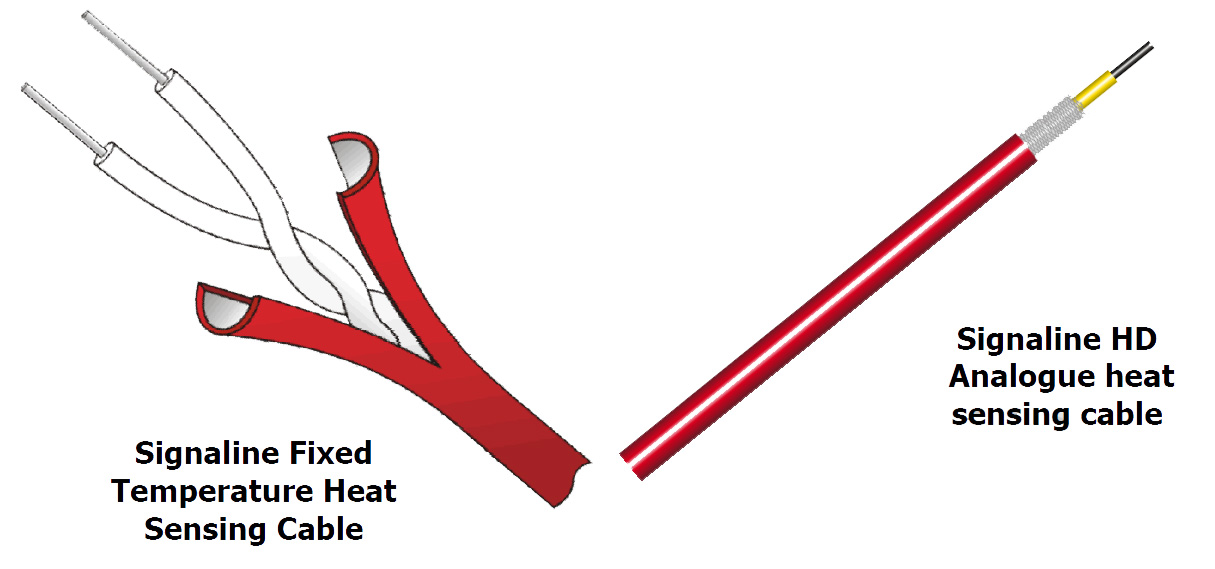
What are Linear Heat detectors?
Signaline Heat Linear Heat Detectors are specialist cables designed to sense heat or sudden increases in temperature anywhere along their entire length. They are designed to be used in commercial and industrial fire alarm systems where conventional heat detectors may be difficult to install, or may not be suitable.
Signaline Heat Linear Heat Detectors can often be cheaper to install than conventional point type heat detectors.
There are two types of Linear Heat Detector cables: Analogue (Signaline HD) and Fixed Temperature (Signaline FT).
Where are Signaline Heat linear heat detectors used?
There are many places where Linear Heat Detectors can be used effectively. Here are some examples:
| Power stations | • Coal conveyors |
| • Power cable tunnels | |
| • Cable trays | |
| Vehicles | • Engine bays of earth moving vehicles |
| • Heavy goods vehicles | |
| • Military vehicles | |
| Railways | • Engine locomotives |
| • Signal cable trays | |
| Ships | • Car ferry vehicle decks |
| • Engine rooms | |
| Petro-chem. | • Floating roof tanks |
| Airports & public transport terminals | • Escalators |
| • Moving walkways | |
| Tunnels | • Road tunnels |
| • Access tunnels | |
| Car parks | • Multi storey or basement car parks |
| Warehouses | • Storage racks |
| • Cold storage rooms | |
| Offices & shopping malls | • Escalators |
| • Basement car parks | |
| • Plant rooms | |
| • Stand-by gen-set rooms |
What is the difference between Signaline HD and Signaline FT heat sensing cables?
Signaline FT is a fixed temperature linear heat detector cable. A fixed temperature linear heat detector cable is a simple form of heat detection. When a specified temperature is reached the construction of the cable breaks down to form an electrical closed contact. In other words nothing happens until a section of cable reaches a certain temperature, then at that temperature the cable acts like a closing switch. Fixed temperature linear heat detectors cannot be re-used. Once it has gone into alarm it must be replaced. This type of cable is also somtimes known as Digital Linear Heat Detectors.
Signaline HD is an analogue linear heat detector cable. Whereas Signaline FT is an on/off alarm, analogue cables monitor the rise in temperature. Signaline HD senses significant increases in temperature. An electronic controller connected to the cable monitors the condition of the cable to sense any change in temperature. This is done by continually measuring the electrical resistance in the cable between the metallic core and the outer braiding. If the change in temperature is sufficient the controller recognises the change in resistance and creates an alarm. The controller is easily adjusted for the length of cable being used. Most importantly analogue linear heat detector cables will reset itself after an alarm when the cable has cooled down unless it has been permanently damaged or destroyed by the heat.
The difference in the make up of the two types of linear heat detector cables is shown in the diagrams:

Both fixed temperature and analogue linear heat detector cables can be easily integrated into intelligent fire alarm systems.
A dedicated Apollo XP95 loop powered controller is available for analogue cables.
Basic DOs and DON’Ts
- DO use analogue linear heat detector cables when it is important to detect a fire as soon as possible.
- DO use analogue linear heat detector cables when a fire is unlikely to give off smoke in its early stages e.g. overheating cables.
- DO use fixed temperature linear heat detector cables when a simple temperature alarm is required.
- DO use fixed temperature linear heat detector cables in high temperature environments.
- DO NOT use analogue linear heat detector cables if the normal ambient temperature is likely to be above 45 °C e.g. in engine bays of vehicles.
- DO NOT use analogue linear heat detector cables if sudden changes of temperature can be expected under normal working conditions.
- DO NOT use fixed temperature linear heat detector cables when sophisticated fire and fault monitoring is required.
- DO NOT use fixed temperature linear heat detector cables when it is likely to be regularly ‘flexed’ or subjected to frequent bending in the normal course of work. This is because digital cable is much stiffer and less flexible than analogue cable.
